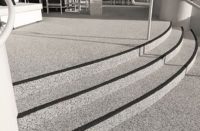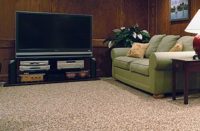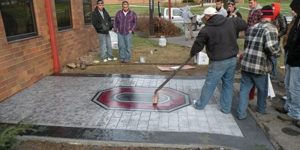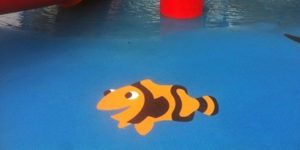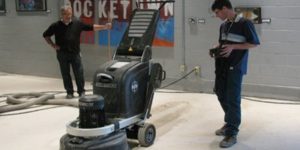Of the many responsibilities that a contracting company takes on when it accepts a floor coating job, none is more important than designing for safe footing once the area has returned to service.
There are two basic long-term objectives the contractor must meet when considering nonskid options:
Traction: Proper traction will keep pedestrians safely on their feet and out of both a doctor’s and a lawyer’s office.
Aesthetics: Keeping an eye on aesthetics will help you maintain harmony in the visual aspects of the project. Aesthetics also includes being able to keep the floor clean.
The “static coefficient of friction” (SCOF) is used to measure the amount of force it takes to overcome resistance to movement between the contact areas of two objects (a floor and the sole of a shoe, for example, or a floor and a forklift’s tire). Regardless of a floor coating’s natural slip resistance, there are three variables that will impact a floor coating’s SCOF once the floor coating is installed: the floor coating’s texture, wetness of the surface (with water, oil, grease or something else), and how level a floor is (or conversely, the degree of slope the floor surface has).
Prior to coating a floor, the professional floor coatings installer must consult with the end user to determine if the floor will normally, sometimes or never be wet or dry and if the surface is flat or sloped. With these two questions answered, it’s the installer’s responsibility to determine the best texture that will offer both safe traction and acceptable aesthetics.
It’s also the installation company’s responsibility to get written approval from the end-user customer, in addition to any involved third parties such as GCs, as to the type and amount of texture a finished coating will have.
The texture of a floor coating is usually adjusted by using some type of particle or grit to improve slip resistance. When covered by a high-performance coating, concrete floors lose their natural texture and their ability to absorb liquid. The result is that any liquid substance, which comes to rest on the coated surface, has nowhere to go until it’s either cleaned or it evaporates. Incorporating particles into the coating builds the surface contact points up and away from the otherwise flat, smooth surface.
The particle that’s used to create texture can vary, too, in four important ways:
Particle size: In this case, size matters in relation to the thickness of the coating. On average, 40 to 60 percent of the particle should protrude above the floor coating. This also means that 40 to 60 percent of the particle should be embedded in the coating film to keep it from being dislodged under the stress of traffic.
Particle shape: Particles that have a more angular, less rounded shape will offer greater traction. Think of trying to walk across a floor strewn with small ball bearings as opposed to one covered in broken glass.
Particle hardness: Soft particle materials made of polypropylene (such as H&C Shark Grip) or acrylic (Res-N-Sand, from my company, Arizona Polymer Flooring) can be mixed into the coating material because they’re lightweight and they tend to stay evenly suspended in the coating liquid during application. Because they’re soft, they should be used in light residential applications only.
Hard, highly abrasion-resistant particles like quartz sand, glass beads, walnut shells, aluminum oxide and others are heavy and must be broadcast into the coating surface. However, these harder materials will not be easily eroded by frequent and intense commercial and industrial traffic.
Particles per square inch: If all other aspects of a textured surface are perfectly designed but too few particles are used, slip resistance may be compromised. If too many particles are used in a given area, the ability to keep the floor clean may be difficult. Getting the balance right from the beginning can mean the difference between a satisfied customer and a service nightmare.
Typically, the above-mentioned lighter materials will be used at a rate of 3 to 5 ounces per gallon while a heavier particle like aluminum oxide will be broadcast at a rate of 5 to 7 pounds per 1,000 square feet.
Once the elements that can make a floor surface slippery are understood, it’s relatively easy to achieve a safe, nonslip surface, which will benefit all who access it. The consequences of not doing so can be equally harmful to all concerned parties. When in doubt, consult your floor coatings manufacturer for their guidelines.
Note: This article is reprinted from the Arizona Polymer Flooring website. If you want more information, APF has published a technical bulletin titled “Measuring Surface Traction and Engineering for Slip Resistance.”

